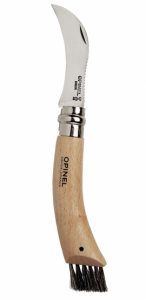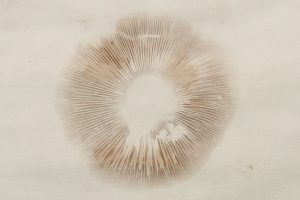Mushroom hunting is generally pretty low tech, but there are a few items that make your mushroom hunt easier and more productive. Obviously, you wouldn’t wander out into the woods without good walking shoes, a water bottle, sunscreen, and foul-weather clothes, but here are a few essential mushroom hunting tools you might not have considered.
Foragers are divided on the best way to harvest a mushroom. Some people cut it off at soil level, and others use their fingers to dig down and lift the mushroom up from the base. Because certain identification characteristics are located below the soil, I use my bare fingers to dig under the base of the mushroom and gently lift it up, preserving as much of the base as possible. So you might wonder why I need an Opinel mushroom knife.

So many reasons:
1) The brush is perfect for gently cleaning soil from the gills and stems of your mushrooms.
2) The curved blade lets you carve off the outer layer of the stem that was below ground, preserving the clean, inner flesh.
3) The blade is sharp enough to cleanly separate a bracket fungus from tree bark without damaging either the tree or the fungus.

Small paper bags keep different mushroom species separate in your backpack. Paper and waxed paper allow the mushrooms to breathe, but fungus wrapped in plastic bags may quickly turn to mush. In a pinch, you can roll your mushrooms in sheets of waxed paper or parchment paper, then twist the ends to hold them in place.
Leave the cute little mushroom basket at home! Hide your harvest in a backpack or something that won’t let other foragers know exactly what you’ve found and where.

There are many excellent volumes on wild mushrooms, but when you’re out in the field, a small, pocket guide is super convenient. It helps with identification and also offers information on edibility. If you can eliminate the most obvious non-edibles in the field, you’ll have more room for tasty fungi in your backpack.

When you get home, you’ll often need to take a spore print to confirm the identification of your harvest. Black paper is best for showing light-colored spores, and white paper is recommended for showing dark spores. This is often the final key in mushroom identification.
Leave a Reply